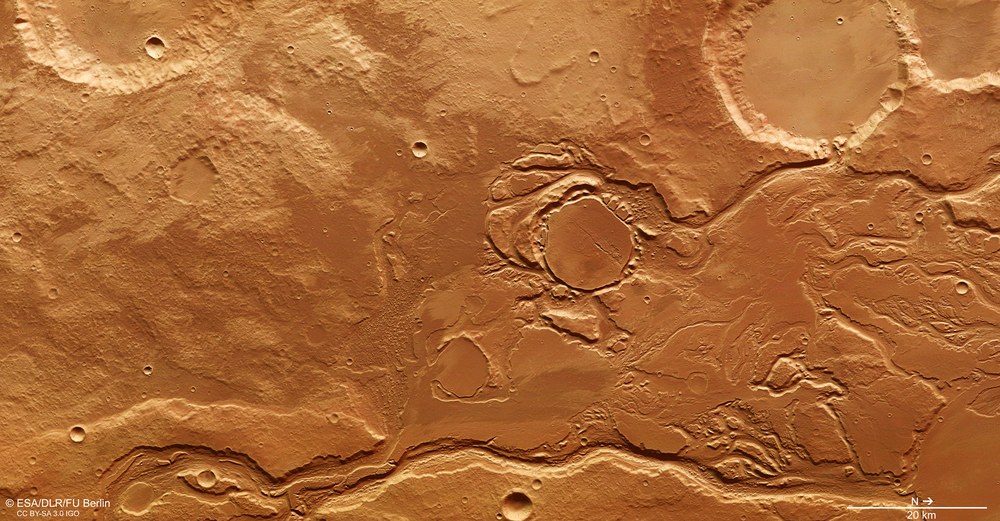Enormous masses of water flowed through Mangala Valles and Minio Vallis on Mars



During Mars' geological 'Middle Ages' – the Hesperian Period – which began 3.7 billion years ago and lasted until approximately 3.1 billion years ago, strong volcanic activity was present on our neighbouring planet. Volcanoes spewed low viscosity lava that poured out in masses over the surface and gave rise to extensive plains. Rising magma prompted the crust to bulge upwards, causing tectonic tensions to develop as a result of the volcanic activity. In many places, the Martian crust broke up and produced fissures or graben systems such as Valles Marineris. The Tharsis region was formed during this period – an area as large as Europe that bulged out into a shield several thousand metres high as a result of volcanic processes. At the southwestern slope of the Tharsis region lies the largest valley system, Mangala Valles, as well as the smaller Minio Vallis. The latest images acquired by the High Resolution Stereo Camera (HRSC), operated by the German Aerospace Center (Deutsches Zentrum für Luft- und Raumfahrt; DLR) on board ESA's Mars Express spacecraft, show the central part of Mangala Valles. This was probably the source of enormous masses of water that flowed out, heading over the Martian surface and carving out Minio Valles in the process.
Volcanism and its consequences
But how did these masses of water arise? Mangala Valles is located in an east-west fault zone several hundred kilometres in length. During an episode of increased volcanic activity, hot, molten rock could have reached the surface during the formation of the Tharsis bulge, melting any existing ice. The resulting masses of water then flowed out to several hundred kilometres north of Mangala Vallis, forming the Mangala Valles and Minio Vallis outflow channels. The word Mangala is 'Mars' in Sanskrit. The name was proposed by the renowned astrophysicist Carl Sagan. India's Mars spacecraft Mangalyaan ('Mars craft'), which has been observing Mars from orbit since 24 September 2014, is also named after it.
The masses of water flowed over multiple impact basins and craters that were already partially or completely filled with sediments, and flowed through numerous rilles in a northerly direction towards the Amazonis Planitia lowlands. Such an impact basin with a drainage channel is located in the upper right corner of the image in the plan views (north is to the right in the images). The crater has a diameter of 28 kilometres.
A somewhat smaller and older impact crater can be seen in the centre of the image – it was once filled with material that eroded later on. Chaotic terrain emerged at its rim; this type of terrain is found elsewhere on Mars. It is characterised by the random arrangement of blocks of the surface material of varying sizes and elevated areas similar to mesas. Chaotic terrains result from the release of underground water and the subsequent collapse of the surface, during which the terrain blocks fall in on themselves and give rise to a 'chaotic' landscape. The existence of such a region at this location strongly suggests the presence of large amounts of ice underground, and that there were different stages of flooding.
Sporadic water activity up until the recent Martian past
A deep valley meanders through the landscape in the lower (eastern) half of images 1, 3 and 5. This landscape features many different surface features, such as flattened slopes with terraces along the sides of the valleys and streamlined islands. Chaotic terrains appear here as well – these are located in the direction of flow of the water masses through the valley. The size and frequency distribution of the impact craters suggest that Mangala Valles was formed in the Hesperian Era and that water activity existed sporadically until the Amazonian period – the most recent geological era on Mars – which began about 3.1 billion years ago.
Image processing
The images were acquired by the HRSC on 12 July 2015 during Mars Express orbit 14,622; they are located at 208 degrees east and 7 degrees south. The image resolution is approximately 16 metres per pixel. The colour image (image 1) was captured using the nadir channel of the HRSC, which is directed vertically down onto the surface of Mars; the perspective oblique view (image 2) was computed from data acquired by the HRSC stereo channels. The anaglyph image (image 3), which creates a three-dimensional impression of the landscape when viewed with red/blue or red/green glasses, was derived from the nadir channel and one stereo channel. The colour-coded aerial view (image 5) is based on a digital terrain model of the region, from which the topography of the landscape can be derived.
The HRSC experiment
The High Resolution Stereo Camera (HRSC) was developed at DLR and built in collaboration with industrial partners (EADS Astrium, Lewicki Microelectronic GmbH and Jena-Optronik GmbH). The science team, which is headed by Principal Investigator (PI) Ralf Jaumann, consists of 52 co-investigators from 34 institutions in 11 countries. The camera is operated by the DLR Institute of Planetary Research in Berlin-Adlershof.
